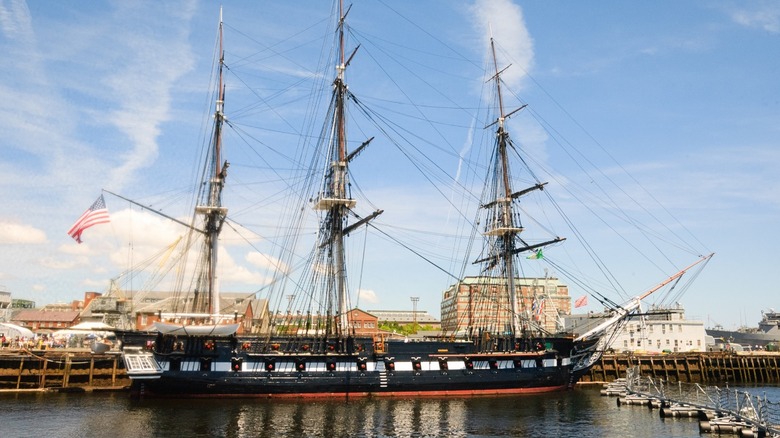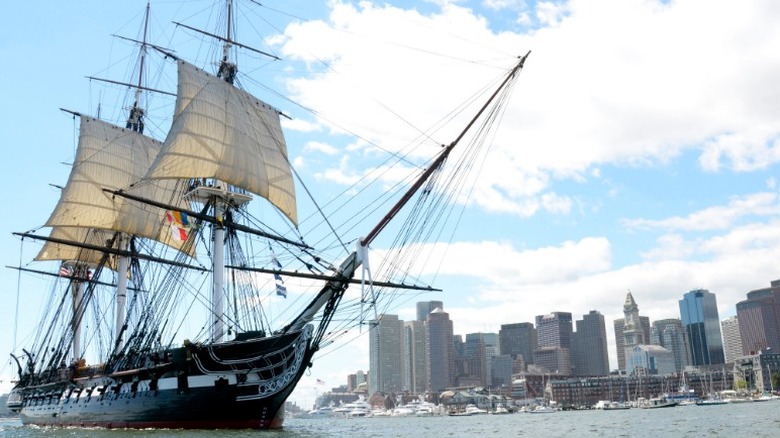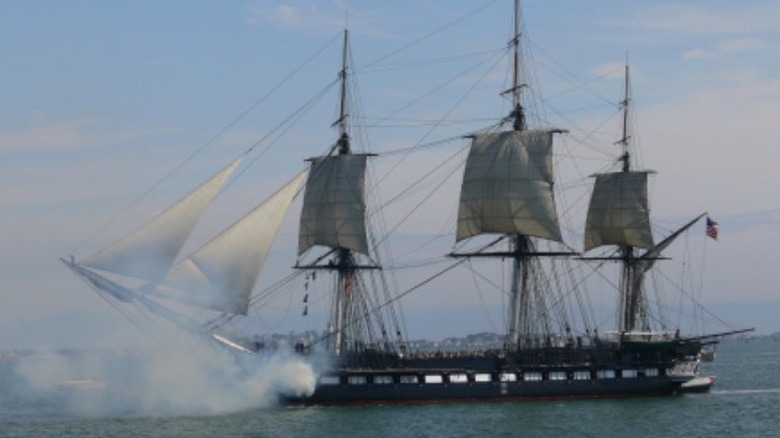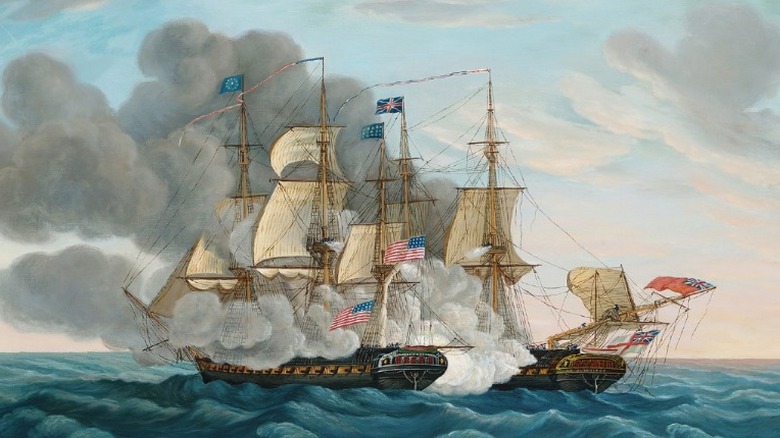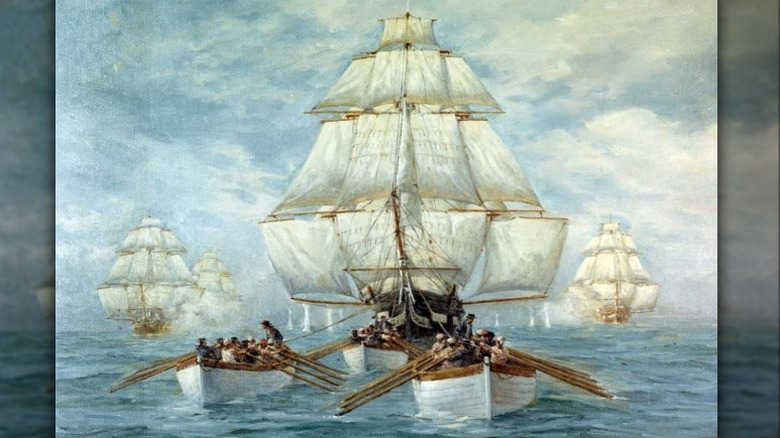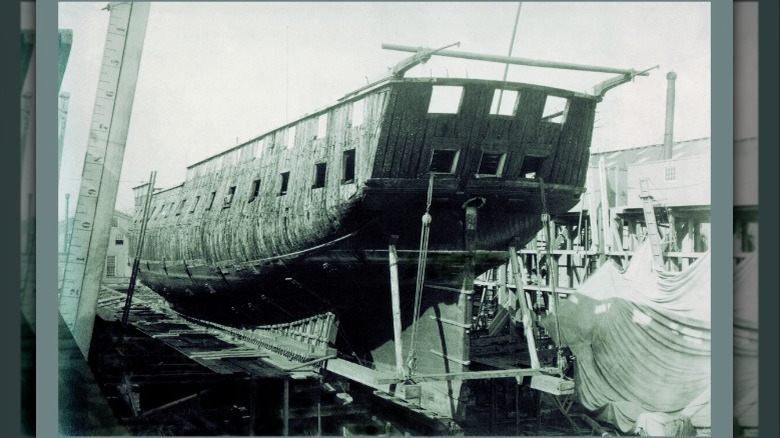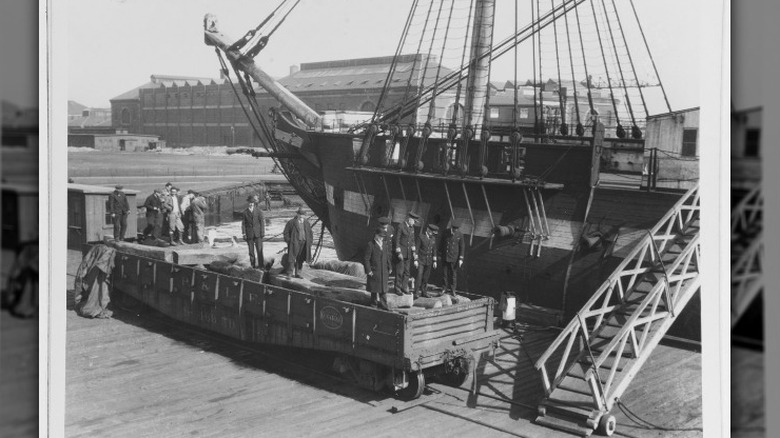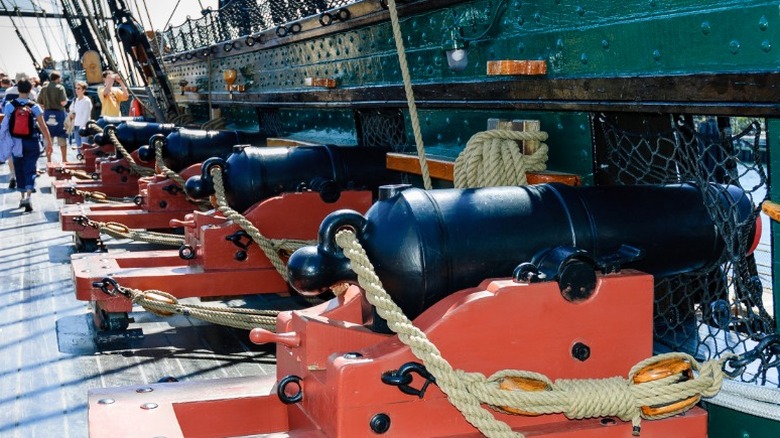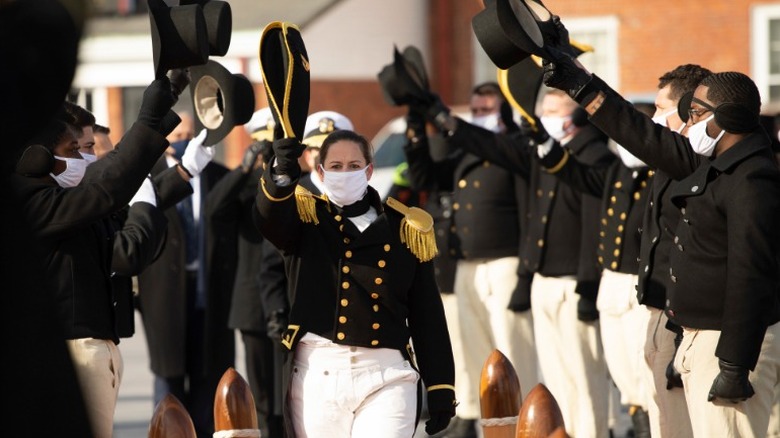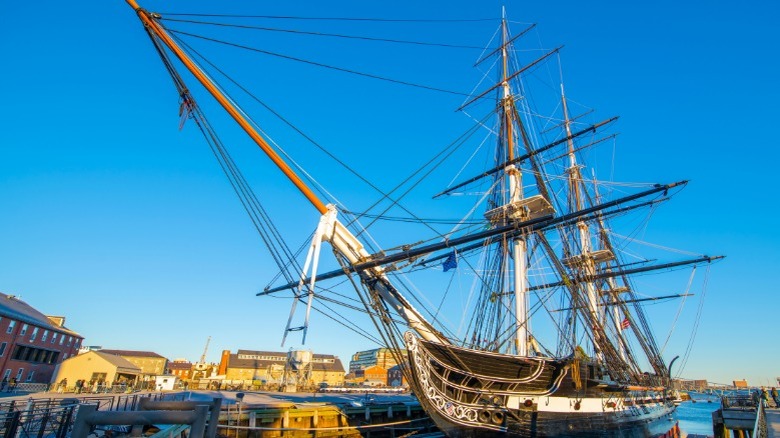The Incredible History Of The USS Constitution: The World's Oldest Ship Still Afloat
The United States has the most advanced and technologically capable armaments in the world, and its Navy has the biggest, strongest, and most fearsome ships on the sea. Yet, there was a time that the U.S. Navy was but a fledgling organization seeking to assert itself among the long-established great powers of the world, including the empires of the British, French, and Spanish. While the Continental Army of the American Revolution was accompanied by a Continental Navy, most naval power on the side of the colonies was projected by its ally, France. But once independence had been established, it was up to the United States itself to provide its own security, and that meant establishing its own military organizations.
The forces amassed to gain independence would later be rolled into official fighting forces for the new country. While many of the founders, such as Jefferson and Madison, objected to having a standing army, others, including Adams, strongly advocated for the creation and keeping of a standing military, much like other world powers of the day. Shortly after the adoption of the U.S. Constitution, the U.S. Navy was founded. At about the same time, the construction of naval ships commenced, including the USS Constitution, which still exists today. This is the incredible story of that ship, the oldest one still afloat today.
Founding of the United States Navy
With the passage of the Act to Provide a Naval Armament by Congress on March 27, 1794, the United States Navy was created. This came about as a result of American merchant ships being accosted by pirates in the Mediterranean. Ships sailing from the Barbary Coast, modern-day Libya, attacked American vessels with impunity at the time, boarding them and taking goods under threat of cannon and gunfire. This caused great concern for the nascent federal government tasked with protecting its citizens and ensuring their safety. Furthermore, piracy posed a threat to American commerce, and the trade being conducted on the seas was vital to the well-being of the nation.
Threats to the nation were coming from multiple sources at the time. Barbary pirates supported by the British were taking American ships by force while the French used privateers to harass American ships as part of its conflict with the British. Furthermore, while the French were allied with the United States and had helped with its fight for independence, the French Revolution put diplomatic relations in flux and threatened to devolve into war at any time. Supporters of the bill claimed that a standing Navy was crucial to the defense of America and her sailing ships, while opponents claimed that cost and the overstepping of bounds by the central government should prevent its passage. In the end, supporters prevailed, and President Washington signed the bill into law, creating the Navy with a mandate for six new frigates, of which the Constitution was included.
Building of the USS Constitution
Immediately following the creation of the Navy, construction of its new frigates began. The Constitution's construction began in 1794, lasting until its launch on October 21, 1797. The ship is made from white oak and live oak with a three-layer hull. Live oak is an evergreen oak resistant to disease and decay, making it ideal for shipbuilding. The use of this timber is what makes the Constitution such a tough and durable ship, which is part of its success in battle and why it still sails today.
The Constitution and its five sister ships were built to be the best possible for their time, using high-quality timber and advanced engineering to the degree possible. The thickness of the hull at the waterline is 22 inches, and it is said that the live oak and its thickness are responsible for some shots being repelled when fired by the British in 1812. The original crew consisted of 450 sailors and marines, and they operated up to 24 32-pound carronades, a short and heavy gun similar to a cannon, and 30 24-pounder long guns capable of hitting targets up to 1,200 yards away. Cost of the ship was $302,718, about $7,249,190 today, according to the CPI Inflation Calculator. The Constitution was part of what could be considered a long tradition of the building of the best possible naval ships and equipment by the U.S. Navy that continues to this day.
USS Constitution in naval service
The Constitution started its service aiding the new United States Navy in defending merchant ships from America's ally in the revolution, France. The French were in the practice of seizing American merchant ships en route to Britain as part of its campaign against the British, seeing the destruction of trade between the U.S. and Britain as deleterious for its foe across the English Channel. By the turn of the century, relations with France had been resolved, and the attention of Constitution's crew was set on the Mediterranean and the Barbary pirates attacking American vessels off the coast of North Africa. It would remain for four years in the area and participate in the bombardment of Tripoli, showing the capabilities of the Constitution and the prowess of the American Navy.
After Tripoli, the United States entered a period of peace. However, American merchants continued to be harassed by the British, who pressed Americans into Royal Navy service. These acts, which most would consider a form of kidnapping, resulted in up to 5,000 Americans being taken for forced military service. This caused the United States to declare war on Britain, and the Constitution then found itself battling the mighty British Navy during the War of 1812. The Constitution and its crew stood undefeated in battle, earning Captains gold medals for valorous service. The ship continued to sail, protecting American interests for another four decades before being removed from service in 1855 with a near-perfect record of wins in battle. But as steam power began to come online, it quickly became obsolete.
Important battles of the USS Constitution
Part of what makes the USS Constitution so special is not just that it still exists, but it exists as an undefeated military vessel. Its crew fought many battles on both sides of the Atlantic starting around 1800, with the final military action taking place as the crew took possession of an illegal American slave ship, the HN Gambrill, in 1853.
In its first days, Constitution battled the French and then took part in the attack on Tripoli, sending 262 rounds of cannon fire at the coastline, eventually forcing a peace treaty to be signed. It then served against the British in the War of 1812 when it encountered a grouping of British vessels, and Captain Isaac Hull managed to outrun them in a 50-hour chase, despite being outmanned and outgunned. Later it encountered the HMS Guerriere and was fired upon, only for the cannon shell to bounce off the hull, giving rise to the nickname "Old Ironsides." Constitution returned fire, striking the Guerriere and sinking it, leading to rejoicing and praise when news returned home. The Constitution once again found itself in a match near Brazil against the HMS Java, a smaller and faster ship, and destroyed it after a heated battle in which the ship took several direct hits.
Just two days after the War of 1812 had concluded and, having no way of knowing about it, the Constitution engaged HMS Cyane and HMS Levant off the coast of Spain. Despite being disadvantaged, the Constitution garnered surrender from both ships, leaving the sailors in Portuguese custody and returning to America with the Cyane in tow. This was the Constitution's final wartime battle.
Period of decline
The Constitution's service record in its first few decades was exemplary and continued to be a valuable asset to the Navy fleet. However, as the years went on, newer ships were built, and new technology emerged that could have turned it obsolete. Furthermore, years on the sea weathered the ship, and it began to show. In 1830, rumblings about possible plans to scuttle the ship became public, and Oliver Wendell Holmes, Sr. penned a poem called "Old Ironsides," which rejuvenated interest in the ship and saved its timbers for sailing on a bit more.
Despite its new lease on life at that time, the ship would be retired from service in 1855. It was kept in ordinary — to be temporarily decommissioned in port with its rigging, masts, and guns stored — in Portsmouth, New Hampshire. 1857 saw the Constitution being refit for use in a naval ship school and later transferred to the United States Naval Academy in Annapolis, Maryland. During the Civil War, it was relocated to Rhode Island and continued to be used for training before returning to Annapolis and then became a floating office ship.
After years of languishing and being moved occasionally to other ports, it was brought back to Boston, where it was built, to celebrate its centennial. While grand celebrations surrounded the event, the old Constitution had fallen into disrepair and failed to garner enough support for any significant repairs.
Rediscovery and restoration
Following the centennial event, the Constitution remained in Boston. It was suggested in 1905 by the Secretary of the Navy, Charles J. Bonaparte, that the decaying ship be taken out to open waters and used for target practice. However, a Boston businessman named Moses Gulesian caught wind of the idea and instead offered to purchase the old boat for $10,000. While the U.S. government turned down the offer, the Boston Globe heard about it and put the story in the paper, which quickly spread into a nationwide headline.
Gulesian thought that destroying a relic from the early days of the country would have been a mistake and wanted to save the Constitution. But with the news sweeping the nation, a groundswell of support arose to put pressure on the government to save the Constitution instead. Gulesian increased his offer but was told that only Congress could authorize the sale of the ship. Instead of doing that, Congress appropriated up to $100,000 for the restoration of it. By 1916, the Old Ironsides Association had been created, and a genuine effort to preserve a unique part of American history was firmly established.
The museum ship
With a renewed interest in the Constitution and funding for its restoration, work began to save the ship. It was showing signs of decay by the mid-1920s and underwent a comprehensive restoration in drydock starting in 1927, still in Boston. After much work was completed, it was ready for the public.
With a crew of 81 officers, sailors, and marines, the Constitution in 1931 set off for a National Cruise with more than 70 planned stops at port for public exhibition. This was, in part, done as a thank you to the many patriotic Americans who had chipped in to fund the restoration of the ship, including schoolchildren who contributed pennies, nickels, and dimes totaling $154,000. For this journey, the USS Grebe towed the Constitution to ports on the East and West coasts as well as the Gulf of Mexico. It was greeted with much fanfare and visited by the locals along with politicians and dignitaries while the crew and officers provided information about the ship to its visitors. It proved to be a memorable event for those fortunate enough to enjoy it. Following the cruise, the ship was moved to Boston, where it remains on exhibit in conjunction with its museum.
As its bicentennial approached in the '90s, more work was put into the Constitution to make it seaworthy. Navy personnel had always been caretakers of the ship throughout its history, and, in 1996, for the first time, its commander was a female, Lt. Commander Claire V. Bloom. She also had the great honor of being the first to command the ship as it sailed under its own power, making it the oldest ship able to be sailed in existence.
Current crew of the USS Constitution
Sailors in today's U.S. Navy have to be trained to operate the most advanced technology on Earth. They have the most sophisticated and powerful weapons and machinery at their command, and all of it takes rigorous training for complete readiness. Yet, some lucky sailors spend eight weeks training to serve in the most advanced navy in the world only to find assignments on a ship equipped with technology no newer than 1813 as one of the 79 crew members that keep the ship sailing today.
Modern sailors rarely require sails, but those on the Constitution are intimately familiar with them and how they are used to harness the power of the wind. On the ship is a crew of 79 who have completed the standard requirements to join the Navy and later trained specifically for the Constitution. While they study 18th-century sailing skills and tactics, they serve as ambassadors to the public in a ceremonial and promotional role. Assignment to the Constitution is a privilege for these sailors, and they have to apply and pass a thorough application process.
The crew of the Constitution all wear regulation Navy uniforms consistent with the standards of 1813. The ship has been restored to the same condition as it was during the War of 1812, and the authenticity goes down to the clothes on board. While the crew is unlikely to see any future military engagements while on board, they can be proud to say they have served not only on the Navy's oldest ship but also one that is undefeated in battle.
Legacy of the USS Constitution
At the founding of the United States of America, there were no guarantees the country would last, nor were there any indications it should become the center of wealth and power it has become. Early Americans fought hard for independence and continued the fight to keep the country together while battling adversaries, sometimes far from home. The new nation's Navy played an instrumental role in protecting American citizens at home and abroad, and the six frigates commissioned with the founding of the Navy were central to projecting power and securing peace.
Unlike five of those frigates, the USS Constitution remains. It has served for more than two centuries, fighting and winning battles and later falling into disrepair, only to be saved by the citizens it served to protect. As a symbol of the enduring history of the United States, not much can compare to the Constitution. It is not just an old boat. It is a grand piece of 18th-century craftsmanship and technology adorned with an artistic style lost in modern shipbuilding. And as it has been brought back to the condition of its heyday when it stood undefeated in battle in the War of 1812, the USS Constitution can honor the past by presenting a glimpse of the former glory of the U.S. Navy for the next generation and those to come. Only by preserving the past and holding it with reverence can we work to uphold our highest ideals as a country and continue to be a great country nation in the future.
